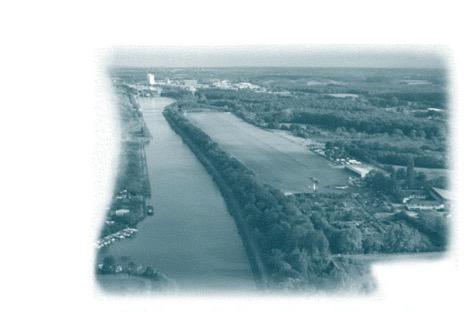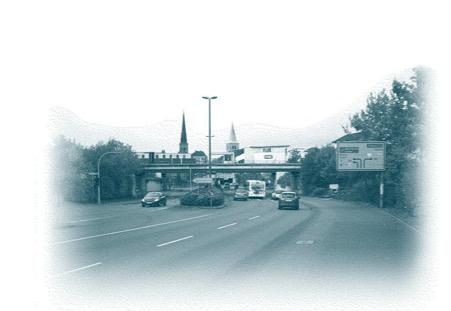




 [Radtour SŘd1]
[Radtour SŘd1]
History of Dorsten - Station: 33 Feldmark Translator: Lyn

A little-known fact: There was a tram in use from 1921 in Dorsten. The centre of the town of Recklinghausen was the tram destination and the terminal in those days was at the address "Vestische Allee", in the area of the big concrete cube on the square known today as "Platz der Deutschen Einheit".
The, in the meanwhile, 33rd History Station dedicates itself immediately to the area known as Feldmark and is positioned directly in front of the restaurant "Gastst├Ątte Maas-Timpert" at the address "Bochumer Stra├če".
The Mayor acrredited this and all of the other History Stations in the town as being a "good sign of close co-operation" ("sch├Ânes Zeichen der Verbundenheit") between church, institutions and societies. In particular, because this plays an important role regarding this new plaque. This (plaque) does not go back as far in history as do the other History Stations in the town's area: The year 1892 and the glassworks "Dorstener Glash├╝tte" mark the beginning.
The History Club, led by Dr. Josef Ulfk├Âtte again did some research and spoke, for example, with Franz Maas-Timpert or Ludwig Klapheck, who could relate a lot of knowledge and quite a few details about the sport grounds in this town district.
Ulfkotte outlined the problem: "What did we have to mention? But it will never all fit on the plaque." (ÔÇ×Was m├╝ssten wir alles erw├Ąhnen? Aber es passte l├Ąngst nicht alles auf die Tafel.ÔÇŁ). So, the creators and designers put together relevant dates and facts, which even some people living in the district of Feldmark (Feldm├Ąrker) might no longer be aware of, assumed Mr L├╝tkenhorst in his short welcoming words. "Some of it is maybe no longer well-known by everyone" ( ÔÇ×Manches ist vielleicht nicht mehr allen so gel├Ąufig.ÔÇŁ)
"It was important to put the area of Feldmark into historical context." ÔÇ×Es war wichtig, die Feldmark historisch zu ordnen.ÔÇŁ
Translator's Note: The source of the text that I have translated is given as: WAZ_Dorsten, 25.01.2010, Andreas Rentel
|
|
1892 |
_ |
The glass and mirror manufacturing company "Glas- und Spiegelmanufaktur AG", since 1914 "Dorstener Glash├╝tte A.G.", starts up its business. | |
 Celebration of the Construction of the new Gasworks. |
1900 |
_ |
The gasworks constructed at the address "an der Katharinenstra├če" in 1865 is replaced by the new plant at the address "im Lindenfeld". | |
|
|
1909 |
_ |
The Royal Teaching Academy "K├Ânigliche Lehrerseminar" is opened at the address "Bochumer Stra├če". | |
|
Following several rebellions. the Manchu Dynasty in China is toppled.
| _ |
1911 |
_ |
The Protestant elementary school "evangelische Volksschule" (later Hindenburgschule, then Martin-Luther-Schule) starts up its lessons. The present-day school, "Johannesschule" at the address "Marler Stra├če" has been in existence since 1958. |
|
Inauguration of the Tramline Dorsten/Recklinghausen  Er├Âffnung der Stra├čenbahnlinie Dorsten / Recklinghausen | _ |
1921 |
_ |
There is a direct tram connection from Dorsten to Recklinghausen, once the section to Marl is opened. |
|
|
1928 |
_ |
The General Citizens' Rifle Club of Feldmark I and II, "Allgemeine B├╝rgersch├╝tzenverein Feldemark I und II", established in the previous year, celebrates its first f├¬te "Sch├╝tzenfest". The Club opens a shooting range "Schie├čssportanlage" in 1972. | |
|
The Second World War ends with the non-conditional Capitulation of Japan (2.9)
| _ |
1945 |
_ |
The hall building "Saal Maas-Timpert", in which French prisoners of war were put during the Second World War, serves as a provisional church during the next years. The suffragan (assistant) bishop, Baaken, consecrates the new church (Kirche St Johannes) in 1960. In the Summer of 2009, the southern parishes merge to become the new large parish of St Agatha. |
 View of the Gliding Airfield |
1959 |
_ |
Following three years of preparation by the Gliding Club in Dorsten "Luftsportvereins Dorsten", the gliding airfield can be handed over for its purpose. | |
|
In the FRG, Federal Republic of Germany, ("BRD") the voting age is lowered from 21 years to 18.
| _ |
ab 1970 |
_ |
The town allocates new residential areas for the sites "In der Miere" and "Stadsfeld" and these areas result in a clear increase in the population in the following decades. |
|
|
1998 |
_ |
The town council decides upon the construction of the inter-commununal industrial park Dorsten/Marl "Interkommunaler Industriepark Dorsten/Marl", which is developed using state-owned public funds and has been commercialised since 2004. | |
 The Avenue "Vestische Allee" |
2009 |
_ |
The town develops a new area for building at the site "Feldhausener Stra├če". |
[zurück]
Daten und Fakten
Eröffnung - 24. Januar 2010
Adresse - The street address: 162, Bochumer Str. ( Bochumer Str. 162)
Geodaten - 51.648861, 6.982838
Celebratory Presentation on 24th January 2010
The History Club, under the leadership of Dr.Josef Ulfkotte has researched as usual. The pupils looked things up in the Town Archives "Stadtarchiv" and in the regional calendar "Heimatkalener" and spoke with citizens, who can well remember the recent history.

The pupils of the History Club
The glass presentation plaque was officially presented and unveiled by the Mayor, Lambert L├╝tkenhorst, on Saturday, at a prominent site.

The Mayor with the Pupils
The drummers, "Tambourcorps Dorsten-Hardt" played the opening serenade. Little Cedric "kleine Cedric" proved himself to be a good new-generation Drum-Major. "Nachwuchs-Tamboursmajor".

The drummers "Tambourcorps" with Cedric as the Drum-Major
Ann-Cathrine Zimzik and Tanja Dahmen describe the preparations of the History Station, "It was heatedly discussed, which location should be chosen". "Es wurde hitzig diskutiert, welcher Standort es sein soll".

Ann-Cathrine Zimzik and Tanja Dahmen
The reader of the new History Station learns that in 1911 the Protestant Elementary School "evangelische Volkschule" started up its lessons. In 1945, after the war, the hall building "Saal Maas-Timpert" was used as a provisional church for the interim and had previously housed French prisoners of war. From 1959 onwards, there prevailed a regular usage of the gliding airfield by the gliding club.

The First Readers

